As 21st-century farmers click instructions onto touchscreens using their tractor’s artificial intelligence (AI) driven systems, pictures of old man John Deere’s 1837 model steel walking plow may loom in their mind. Even the grandparents of modern producers, members of the World War II generation, would consider today’s agricultural equipment to be the stuff of science-fiction films. From horse-pulled machinery to steam, to gasoline, diesel, and even electric, the technology behind tractors has come a long way — leading to a bevy of amazing tractor innovations in nearly two centuries of history. And all fans of the field are excited about the future yet to come.
Below are some of the most significant advances in the history of the tractor. That said, no such list could ever hope to be exhaustive as developments in tractor technology date back to the early 1800s. In broad terms though, it’s clear some contributions marked milestones in the fields of history, providing a starting point for a multiplicity of offshoot inventions and improvements.
Agriculture remains a mainstay of not just commerce, but technology, serving as the base from which so much science is created. Upon these 10 advancements, everything now considered a tractor was built — and great expectations remain for what lies ahead.
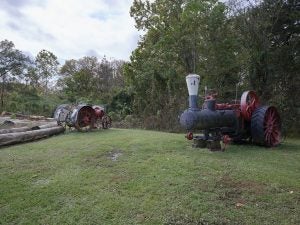
1. The Dream of Steam
Farmers began using steam engines for the threshing of grain in the 1800s with one of the first portable steam engines for agricultural purposes designed by Richard Trevithick in 1812 called the Barn Engine. Trevithick was a British inventor and engineer who pioneered a number of advancements within the steam-powered road and rail industries, and he is also credited with inventing the first high-pressure steam engine and locomotive.
Steam engines continued to be used throughout the 19th century, but most were simply portable steam engines and boilers mounted on wheels. In 1873, Richard Merritt and Daniel Kellogg of Battle Creek, Michigan, formed Merritt & Kellogg to produce one of the first self-propelled steam traction engines, which could move from farm to farm without being hauled by horses.
The year 1876 is often consider a birthdate in the United States for agricultural steam traction engines replacing steam plows with one of the first commercially successful units built by C & G Cooper Co.
2. Giving it the Gas
While horse-drawn equipment dates back ages, the first practical gasoline-powered tractor was born in 1892. Invented by John Froelich in the Clayton County, Iowa, this machine was the first with a gasoline-powered engine to maneuver forwards and backwards.
This was the first of the machines to include a 20-horsepower engine, single cylinder, and clutch. For years prior, steam engines had been used in farm machines, but these were too big and bulky to be affixed to a mobile unit. Froelich, along with blacksmith Will Mann, engineered a vertical, one-cylinder engine mounted on a running gear of a steam engine to craft a machine that would, in its first year, thresh 72,000 bushels of grain. Froelich was go on to launch the Waterloo Gasoline Traction Engine Co.
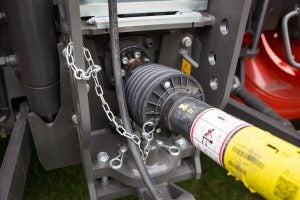
3. The Power Take Off
In 1919, International Harvester invented the first commercial power takeoff (PTO), which was built into the 8-16 model. With an 11-gallon kerosene fuel tank and 4×2 wheel chassis, the machine had a three-speed unsynchronized gear system, four cylinders, and wheelbase of 85 inches. The PTO horsepower was measured at 19 belt and 11 drawbar, with a governed revolutions per minute (RPM) of 1,000.
In olden terms, belt horsepower of the PTO refers to the engine horsepower available by way of the belts and pulleys used in those older models, while drawbar horsepower referred to the maximum ability to pull a dead weight.
4. Mass Production
In 1917, Henry Ford introduced the Fordson Model F just as troops were hungry for food while fighting in World War I. Introduced at a price of $395, the Fordson Model F was the first tractor to be mass produced in the same manner as automobiles, a process revolutionized by Ford himself.
The Model F production ran from 1917 to 1920 at the Dearborn, Michigan, plant. One of the keys to the Fordson’s mass production was that its design lacked a traditional frame, and instead the engine, transmission, and axle housings were bolted together to form the core of the tractor. Smaller and easy to produce on an assembly line, Ford was able to sell these units much cheaper to small farmers across the country.
5. The Three-Point Hitch Comes to Life
Prior to the three-point linkage system, implements such as plows and harrows were effectively towed after being lifted and set onto the tractor’s rear using hand lever systems.
Designed by Harry Ferguson in the early 1920s, the principle he patented in 1925 involved the two hitch points, with a third hitch point added to another patent in 1928. The initial design actually had two upper links and one lower, whereas most subsequent models have utilized two lower links and one upper.
This three-point system is what would allow modern hydraulics to be added to tractors and become more than machines used for hauling and dragging. Ferguson’s Brown Type A was the first tractor to feature this system.
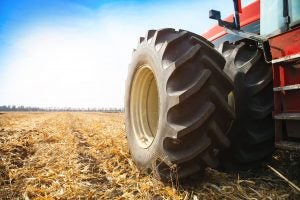
6. Tractors get Pneumatic Rubber Tires
Up through the 1930s, tractor tires were made of metal, typically steel. The problems were considerable as the clanging and banging across dirt roads produced costly damage.
Attempts to produce other forms of tires dated back to the 1800s, but it wasn’t until 1918 that International Harvester became the first manufacturer to outfit a production tractor with solid rubber tires.
That first model had solid rubbers on the front and rubber blocks molded by the Firestone Company to metal lugs on the rear. In 1934, the Nebraska Tractor Test Site conducted test number 223, which was the first using a pneumatic-tire tractor. The next year the Allis Chalmers WC was the first tractor produced from the factory with rubber tires, hitting 8.18 horsepower hours of work per gallon of fuel versus the 5.62 achieved by metal lug wheels.
By 1940, more than 90 percent of tractors had rubber tires, largely due to a campaign led by Firestone Company.
7. Make Way for Diesel
Early tractors operated primary on kerosene and gasoline, but attempts to create a tractor using diesel date back to the 1920s. Diesel fuel, as producers and operators alike know, packs more energy into a gallon of fuel than gasoline, therefore making it more efficient.
In 1927, Caterpillar developed a hand-built prototype of a diesel engine named the D9900, or “Old Betsy.” In 1931, Caterpillar began producing its first diesel tractor model, the Caterpillar Diesel Sixty Tractor, and within a few years, the company was the largest producer of diesel engines in the world.
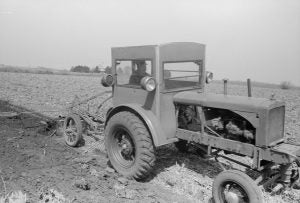
8. Tractors Get Cabs
Every producer knows that farming is a year-round enterprise, and where would modern farmers be without with cabs?
In 1935, Minnesota-based tractor manufacturer Minneapolis-Moline Co. began work on a completely enclosed tractor known as the UDLX Comfortractor, which hit the markets about 1938. The Minneapolis-Moline started with the Model U and its 81-inch wheelbase with a semi-perimeter chassis, with the front axle and engine attached to a frame of a 1-by-6-inch steel plate. The Comfortractor had a top speed of 25 miles per hour.
While the concept of cabs caught on quickly, the UDLX Comfortractor was a financial failure. Launched during the Great Depression, the $1,900 sale price was just too great compared to John Deere models tagged at $1,000 and new 1938 Ford Deluxe Tudor sedans fetching $725. According to the U.S. Bureau of Labor Statistics, $1,900 in 1938 would be about $36,604.04 in 2021, with $1,000 equaling about $19,265.28.
Interestingly enough, modern tractor buyers would recognize those numbers while shopping between larger subcompact tractors with and without cabs.
9. Global Positioning Systems (GPS) Become a Fact
The origins of the Global Positioning Systems (GPS) date to the Cold War era, when the U.S. military built satellite networks for defense purposes. By the late 1970s, the U.S. Department of Defense had launched a Navigation System with Timing and Ranging (NAVSTAR) satellite, and a full 24-satellite system became operational in 1993. Today, GPS is actually a multi-space, space-based radionavigation system owned by the U.S. government and operated by the U.S. Air Force.
Interestingly enough, one of the first groups to jump aboard this new technology was the John Deere Precision Farming group based out of Moline, Illinois. In 1994, the John Deere team’s work in the then-newborn precision agriculture field merged with developments pioneered by defense contractor Rockwell International Corp.’s Vision System and the detailed field maps it created. This system was partnered with computers inside combines to record harvest volume and pair that data with location maps.
Collaboration between John Deere and the NASA Jet Propulsion Laboratory resulted in the first GPS receiver in 1996. By 2018, self-guided systems farmed between 60 to percent 70 percent of the crop acreage in North America, 30 percent to 50 percent in Europe, and more than 90 percent in Australia.
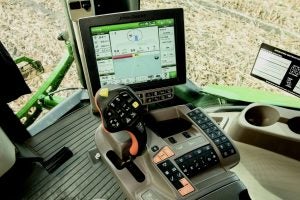
10. Smart Farming and Artificial Intelligence (AI)
In 1837, a man named John Deere brought to the world a new-fangled plow behind which one could walk while handling a team of horses. Imagine his shock if he could see his name as a brand atop the 4640 Universal Display inside a green and gold tractor. The 10.4-inch smart touchscreen offers four-way video camera support as well interconnectivity between the tractor and implements, meaning producers can monitor everything from seed distance while planting to temperature and moisture.
Today, Artificial Intelligence (AI) systems have become so integrated within agriculture that it’s difficult to establish a specific timeline. Once GPS became a reality, computerized tractors and combines instantly became “smarter” with better gauges, sensors, and data-tracking. Whereas producers of yesterday would grip handfuls of earth into balls to test moisture, their great-grandchildren read from computer screens on their own handheld telephones. This allows tractor systems to plant to specific soil depths and space appropriately depending on the conditions.
11. New Holland Methane-Powered Tractor
In keeping with the ancient farmers’ tradition of vertical integration, the T6.180 Methane Power tractor allows operations with biodigesters to use the biomethane from their own production to fuel machines. The 6.7L, 6-cylinder engine is compatible with both biomethane and compressed natural gas (CNG) by way of technology first introduced in 1995. Gas injectors and spark plugs replace the diesel injector, with gas injector into each cylinder for clean combustion.
In terms of performance, this model rivals traditional diesel tractors with a rated engine speed of 2,200 RPM, 175 max boosted engine horsepower, 145 rated engine horsepower, and 126 horsepower at the PTO. In terms of fuel capacity, the tractor has a 49-gallon standard tank with an optional extender. A good-sized tractor, the T6.180 has a 104-inch wheelbase and measures 179 inches in length with an 85-inch width, fender-to-fender. Gross machine weight is 20,944 pounds.
What makes the concept attractive to farmers is the 10 percent to 15 percent reduction in carbon dioxide emissions with 98 percent less particulate matter produced, as well as the opportunity to generate one’s own fuel by way of biomethane.
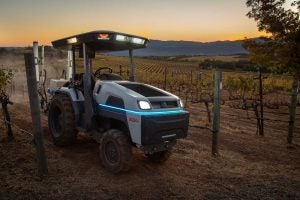
11. The Monarch Electric Tractor
As the 21st century rolls onward into the sphere of all things artificial intelligence, the Monarch Tractor now presents itself as the world’s first fully electric, driver optional, smart tractor, integrated on a single platform. First showcased in December of 2020 in California and commercially available two years later, the MK-V Standard starts at $74,998 and features a peak motor power of 70 horsepower, four-wheel drive, and 40 horsepower at the PTO, with a CAT I/II 3-point hitch. The MK-V measures 146.7” x 92” and comes with standard R1 Ag tires.
But what’s really sparking farmers’ interests is its 14-hour run time against a six-hour charge time, with 5.6kW of exportable power. Sized for all things mowing, tilling, under-row weeding, or loading, the Monarch is designed to work autonomously, with or without a driver in the seat. Equipped with a smart screen, operators have access to 360-degree camera views, interactive mapping technology, and language translators. Developed in connection with California’s wine country for mowing between rows, the company presently produces disc harrows, undervine weeders, rotary mowers, and flail mowers.
13. Massey Ferguson Protect-U Cab Design
If only Harry Ferguson could see today what’s going on with the new Massey Ferguson Protect-U Cab design. Introduced as part of the Massey Ferguson MF 8S Series, the brand’s unique Protect-U cab design features a 24-centimeter, or 9.449-inch, space which separates the engine from the cab and helps dampen the noise, vibration, and heat. This development helps keep the noise of the engine down to 68 decibels, making it the quietest on the market.
Just for reference, 68 decibels is approximately the same as normal conversation between two people and considered safe from hearing damage. Prolonged exposure to decibels over 85 can be damaging one’s hearing.
And just as importantly, this design allows for more room for the engine air intake process and makes for cleaner, cooler air going into the engine. The overall affect is a longer lasting engine and much cleaner, and safer work environment for the operator.
There’s no stopping progress as the old saying goes. And with the population of Earth now nearing 8 billion humans, farmers will have to get smarter yet going forward. Electric engines, solar panels, and more AI seem to be on the menu as genetically engineered crops continue along the pipeline.
It’s amazing to think that once upon a time, the idea of using a steam-powered engine to thresh grain was as shocking as an AI sensor guiding the placement of seed. And it’s downright exciting to imagine where the next 100 years will take the world of agriculture.
Brian Boyce is an award-winning writer living on a farm in west-central Indiana. You can see more of his work at http://www.boycegroupinc.com/.



